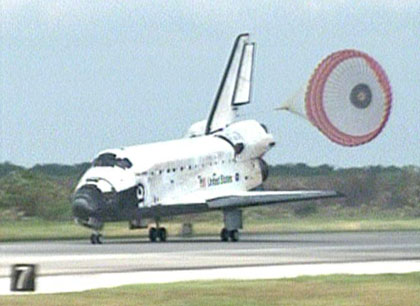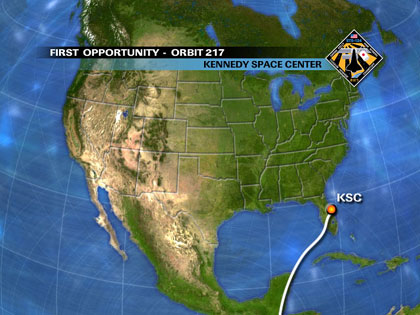The landing took place in the first planned landing window tonight (Saturday) at 18:15 Israel time * Now only ten shuttle missions remain - one of them in October for the Hubble Space Telescope

The space shuttle Discovery returned safely from space in a particularly smooth landing this evening at 18:15 Israel time. Spacecraft commander Mark Kelly activated the shuttle's engines at 17:10 Israel time and thus began the shuttle's entry into the Kennedy Space Center for landing.
After the landing, the astronauts will stay inside the Discovery for about an hour until the hydrazine gas emitted from the shuttle during the landing dissipates.
"Perfect landing Mark and congratulations on a great mission" said the control room manager to Kelly after the shuttle came to a full stop. "We're happy to be back," Kelly said.

The shuttle Discovery took off for the mission on June 2 and brought the Kivu Space Laboratory to the station. Concerns were raised yesterday about the shuttle's ability to return after a rectangular object detached from it and was seen floating away. After examining the videos and photos taken by the crew members, they were informed by the control center that it was a part of the shuttle's deceleration engines, which protects them during launch and has no role in landing. This paved the way for the evening landing which, as mentioned, was particularly smooth.
Ten flights remain until the end of the shuttle project, one of which - in October of this year - is for the last service of the Hubble Space Telescope and the remaining nine to the space station, most of them to bring up supplies and experimental facilities, with the biggest project being the installation of another large solar collector in order to increase the station's power generation capacity. After the end of the project in 2010, NASA will have to rely on disposable rockets to bring equipment, new components and supplies to the station and the services of the Russian space agency in bringing people to the station, which following the STS-124 mission in which the Japanese Kibo component was brought up, it will be able to permanently accommodate six astronauts .

6 תגובות
It would be very nice if you could add pictures.
Anyway, very interesting article.
Thank you.
In two years the shuttles will be retired and will start using the Orion spacecraft
Beauty! - The worry is over.
Why are the cute ferries that have served us for so many years, sometimes faithfully and sometimes treacherously, retired? Are there much better alternatives? Why aren't they used anymore? Are they just too old? Or too expensive? Why not renovate or build new ones?
What about the pictures?